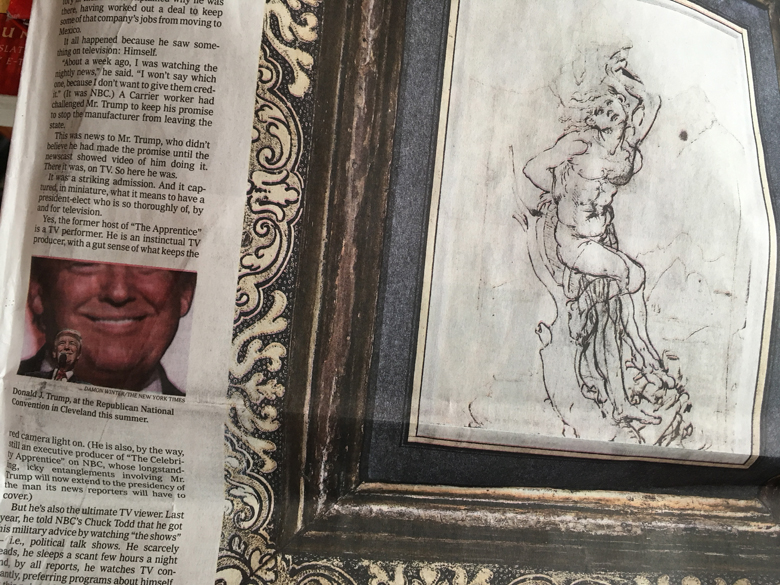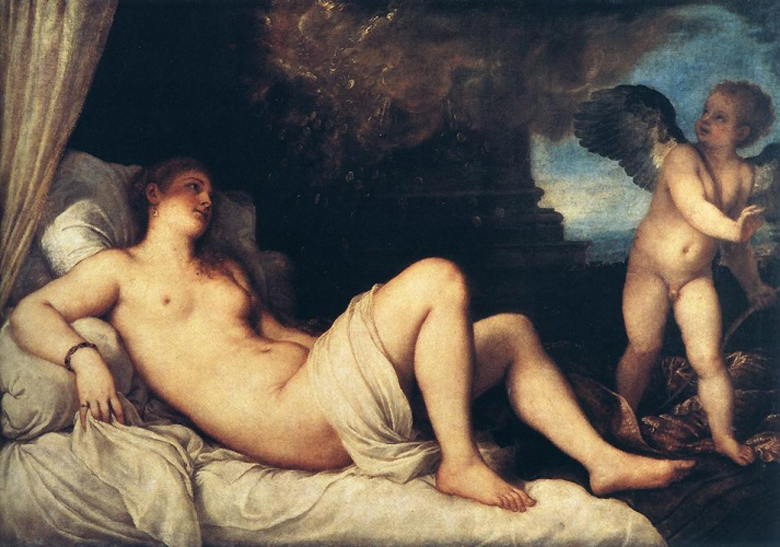CLXXV
Of the components of gunpowder, sulphur is pure positive [yang] and saltpeter is pure negative [yin]. When these two elements come together, the result is noise and change – this being a wondrous thing brought about by the celestial forces.
Sulphur is not produced in the northern barbarians’ country, possibly because the people there do not know how to roast and collect it. Further amazing cannon have been manufactured in the Western Ocean and by the Red [Headed] Barbarians… [Sung Ying-Hsing, T’ien-Kung K’ai-Wu (Chinese Technology in the Seventeenth Century). Translated and annotated by E-Tu Zan Sun and Shiou-Chuan Sun. Mineola, NY: 1966. p. 201]
And the Rockettes, whatever to do? Dance or not dance? Well, really, is it dance? Well, perform at any rate: those flexing, extending, fetish legs subjected to a precise Lipizzaner-like discipline – the staple Nutcracker-hussar costumes, beneath which superbly grown and crafted female members, yes, but swiveling, pivoting upward like the guns on a dreadnought’s turrets, erecting to fire…
You are what I eat
Coca coli
And Radio City Music Hall within spitting distance of Trump Tower, separated only by a Rockefeller’s center and just down the road from Tiffany’s…
Master Sung observes that although Nature has divided time into day and night, man [sic] is able to prolong the day artificially in order to carry out his tasks. The reason is not due to his being fond of toil or disliking leisure. If, for example, the weaver must burn wood for light and the student rely on the glow of snow to read by, how little work could be accomplished in this world!
Stored in the seeds of grasses and trees there is oil which, however, does not flow by itself, but needs the aid of forces of water and fire and the pressure of wooden and stone [utensils] before it comes pouring out in liquid form. [Obtaining the hidden oil] is an ingenuity of man that is impossible to measure.
For the transportation of goods, and travel to distant places, men must depend on boats and carts. One drop of oil [in the axel] enables a cart to roll and one tan of oil used in caulking a ship makes it ready for the voyage. Thus, neither cart nor boat can move without oil. Furthermore, cooking vegetables without oil is like letting a crying infant go without milk. The uses of oil are indeed varied and numerous. [Sung Ying-Hsing, T’ien-Kung K’ai-Wu (Chinese Technology in the Seventeenth Century). Translated and annotated by E-Tu Zan Sun and Shiou-Chuan Sun. Mineola, NY: 1966. p. 215]
On the night of Nov. 16, a group [grope?] of executives gathered in a private dining room of the restaurant La Chine at the Waldorf Astoria hotel in Midtown Manhattan. The table was laden with Chinese delicacies and $2,100 bottles of Château Lafite Rothschild. At one end sat Wu Xiaohui, the chairman of the Waldorf’s owner, Anbang Insurance Group, a Chinese financial behemoth with estimated assets of $285 billion and an ownership structure shrouded in mystery. Close by sat Jared Kushner, a major New York real estate investor whose father-in-law, Donald J. Trump, had just been elected president of the United States.
It was a mutually auspicious moment.
Mr. Wu and Mr. Kushner – who is married to Mr. Trump’s daughter Ivanka and is one of his closest advisers – were nearing agreement on a joint venture in Manhattan: the redevelopment of 666 Fifth Avenue, the fading crown jewel of the Kushner family real-estate empire… [“A Second Empire By Trump’s Side,” NYT, 1/8/17, A1:2]
6 6 6
…Standin’ at the crossroad, baby, risin’ sun goin’ down
Standin’ at the crossroad, baby, risin’ sun goin’ down
I believe to my soul, now, poor Bob is sinkin’ down
You can run, you can run, tell my friend Willie Brown
You can run, you can run, tell my friend Willie Brown,
That I got the crossroad blues this mornin’
Lord, babe, I’m sinkin’ down
And I went to the crossroad, mama, I looked east and west
I went to the crossroad, baby,
I looked East and West
Lord, I didn’t have no sweet woman, ooh well, babe, in my distress…
Robert Johnson, ca. 1936
What, queries Master Sung, is the carrier by which knowledge of Nature’s wonders and the mysteries of the Universe is transferred from ancients to moderns, and from Chinese to foreigners, so that those born in later times can learn it at a glance? If all communication between ruler and subject, teacher and pupil, were by word of mouth, could much be achieved? Yet with the use of a slip of paper or a slim volume of writing, teaching can be accomplished and [government] orders carried out, as easily as the breeze blowing or ice melting in the sun. It is indeed fortunate that in this world exists Old Sir Paper, from which both the sages and the ignorant have benefitted.
Paper consists of fibres and tree barks. White color emerges as the “green” is killed, and thus was taken the first step toward [the existence of] myriads of books and hundreds of specialists and schools [of thought]. This is the refined use of paper. As to its ruder uses, such as shielding against the wind or protective wrapping of things, they were initiated in antiquity… [Sung op. cit., p. 223]
At the beginning of this century, much was still considered “Christian” which has since been recognized as “pagan.” Examples are several fragmentary sarcophagi with bucolic scenes devoted to the ideal pastoral life, especially those with depictions of a shepherd carrying a sheep across his shoulders which were long considered to be allegories of Christ, “the Good Shepherd.”
There was a similar mistaken interpretation of the representation of a reading or teaching philosopher. In their disputes with pagan philosophical schools of the Roman Imperial Period, early Christian writers were fond of terming Christianity the only “reliable and profitable philosophy” (Justin the Martyr, d. ca. 165). For this reason, earlier scholarship regarded the depictions of philosophers… on sarcophagi as references to the Christian faith of the owner. The wonderful fragment with representation of four male figures was long interpreted as a gathering of Neoplatonic philosophers, but more recent research has shown that the piece in fact shows part of two common scenes in the decoration of Roman sarcophagi: a wedding and a consul’s initiation into office… they both refer to the virtues of concordia (harmony) and virtus (virtue) which the deceased practiced in life in the hope of moderating his fate in death… [Arne Effenberger, “Late Antique and Byzantine Art,” Masterpieces of the Pergamon and Bode Museum, Mainz: Verlag Philipp von Zabern, 1995, pp. 108-109]
Similarly, an incorrect interpretation of the figure of a reading man in the decoration of a sarcophagus from Fiesole probably led to the acquisition of this excellent work for the Early Christian collection. In fact, the representation was intended to allude to the owner’s spiritual education and erudition in Classical poetry and philosophy, and to his conduct of his life on that basis.
The deceased appears a second time as a hunter on horseback which signifies not his love of the hunt, but his virtus. The rustic scenes of harvesting evoke the Elysian Fields where the deceased has now taken up his abode; at the same time, they are allegories of the seasons expressing the hope that the existence of the deceased in the beyond might endure eternally… [Ibid. pp. 109-112]
[A sarcophagus from Rome, last quarter of the 3rd century] marks quite precisely the chronological and thematic transition from pagan to Christian imagery. To depict the figure of Jonah, the sculptor borrowed the motif of the sleeping Edymion… Only the gourd vine on the trellis identifies the young man who slumbers in heroic nudity as the Old Testament prophet Jonah. In Roman art the orans (a figure with hands and arms raised in prayer) originally personified the idea of pietas (piety). It is often encountered on early Christian monuments, where it depicts the deceased in a metaphor of blessed transcendency.
The idyllic pastoral landscape, too, is an allegory, symbolizing peaceful existence; even the motif of the man carrying a sheep was sufficient to express the idea of peace. The figure of the slumbering Jonah brings these elements… together to form a compelling Christian paradigm. [Ibid. p. 112]
Ah the ikonography of it all: On the short side of a pseudo-sarcophagus [two slabs, one shorter than the other joined at a right angle and set up in a corner of a mausoleum to give the impression of a four-sided sarcophagus] from Constantinople and dating from the early 5th century “three figures are shown in niches formed by a rich architectural framework with columns whose spiral fluted shafts stand on tall bases… The figure in the center, which is larger and more important than the flanking pair, depicts Christ.
“He wears the costume of Classical orators, poets and teachers: tunic and cloak (pallium) with sandals on his feet. His long, curly hear, bound by a fillet, gives him the appearance of a youthful king. His head is framed by a… halo with a cross. Two apostles in the flanking niches, depicted in the iconography of Imperial notaries holding scroll and writing board (diptychon), turn toward Christ, the regal philosopher.” [Ibid. p. 116]
But then comes the million-figure question: given the worship of so many false gods in the past, could any images, even depictions of persons impeccably holy, serve as a legitimate vehicles for expressing the divine principle embodied in Christ? Did, in short, in a variant strain of Plato’s iconophobia, the image invariably mislead the would-be faithful and potentially corrupt those who had already embraced the one true God? Thus the iconophile/iconoclast pendulum swung both ways for over a hundred years. In 726, Byzantine emperor Leo III forbid icons, and vast quantities of religious imagery was mutilated and outright destroyed. Empress Theodora definitively sided with the iconophiles in 843. In between, in 787, the Second Council of Nicaea gave Caravaggio the nod way avant la figure:
We decree with full precision and care that, like the figure of the honored and life-giving cross, the revered and holy images, whether painted or made of mosaic or of other suitable material, are to be exposed in the holy churches of God, on sacred instruments and vestments, on walls and panels, in houses and by public ways; these are the images of our Lord, God and Savior, Jesus Christ, and of our Lady without blemish, the holy God-bearer and the revered angels and of any of the saintly holy men. The more frequently they are seen in representational art, the more are those who see them drawn to remember and long for those [holy figures] who serve as models, and to pay those images the tribute of salvation and respectful veneration.
…marks quite precisely the chronological and thematic transition from pagan to Christian imagery…
La spéciation, mon amour
History pees itself
Cede Texas to Mexico, FL to Cuba
History and its Bummer-tents
The changes in Titian’s painting in the middle years of the [16th] century gave rise to one of the greatest stylistic revolutions in the history of art. If we had to date its beginning we could cite the journey he made to Rome in 1545. The meeting with Michelangelo, whose great fresco of the Last Judgment had recently been unveiled, seems to have given Titian an even greater confidence in himself. It is significant that he painted the Danaë… during this visit.
Justifying the liberty he took in painting mythological figures, Titian declared that he created them in the manner of a poet rather than a story-teller. This explanation could be extended to his new way of applying color. Vasari, who visited him in his studio in Venice in 1566, provides the following explanation: “The manner he employs in his latest paintings is very different to that of his youth. They are executed with bold, sweeping strokes, with the result that little can be seen in them when viewed from nearby, but viewed from a distance, they appear perfect. The method he uses is judicious, beautiful, and astonishing, because it makes the paintings appear alive and painted with great skill, but conceals the effort.” [Tomàs Llorens, María del Mar Borobia, Concha Vela, Guide of the Thyssen Bornemisza Museum, Madrid, 1996, p. 48]
There is a species of illusionism in art, of a different order than that of Zeuxis and Parrhasius, vying to fool the animal senses.
It is that subtle, but real distinction between the high relief and the free standing statue: i.e. the full separation of the individual(s) from lateral support. Now, one is truly on one’s own. Accompanied only by one’s shadow, and, as ever, by unrelenting gravity.
No relief. And only one direction home.


